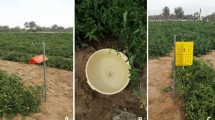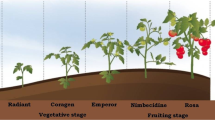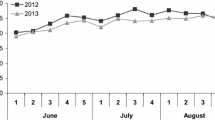Abstract
Since its first detection in Tunisia in 2008, the tomato pinworm, Tuta absoluta, has become a serious problem to tomato crops by causing heavy yield losses. The aim of this work was to evaluate the efficacy of some actives ingredients, commonly used by Tunisian farmers, under laboratory and greenhouse conditions in controlling T. absoluta larvae. We also tested the role of mass trapping as control method for T. absoluta while performing two greenhouse trials: one to test the most effective number of pheromone traps to be used and the second evaluating the combination of insecticides and pheromone traps. Our study demonstrated that the product combining abamectin and chlorantraniliprole was the most effective 2 h after the treatment in laboratory trials. Moreover, this study indicated that the dose of two sex pheromone traps/greenhouse was the most effective compared to the other tested dose. Also, mass trapping alone (2 sex pheromone traps/greenhouse) was not effective in reducing larval populations: flubendiamid and cyromazin caused 96 and 77% larval mortality, respectively.






Similar content being viewed by others
References
Abbes K, Chermiti B (2011) Comparison of two marks of sex pheromone dispensers commercialized in Tunisia for their efficiency to monitor and to control by mass-trapping Tuta absoluta under greenhouses. Tunis J Plant Prot 6:133–148
Abbes K, Harbi A, Chermiti B (2012) Comparative study of 2 protection strategies against Tuta absoluta (Meyrick) in late open field tomato crops in Tunisia. OEPP/EPPO Bull 42(2):297–304
Abbes K, Biondi A, Zappala’ L, Chermiti B (2014) Fortuitous parasitoids of the invasive tomato leafminer Tuta absoluta in Tunisia. Phytoparasitica 42:85–92
Abbott WS (1925) A method of computing the effectiveness of an insecticide. J Econ Entomol 18:265–267
Allache F, Houhou MA, Osmane I, Naili L, Demnati F (2012) Suivi de l’évolution de la population de Tuta absoluta Meyrick (Gelichiidae), un nouveau ravageur de la tomate sous serre à Biskra (sud-est d’Algérie). Entomologie Faunistique/Faunistic Entomology 65:149–155
Andrade GS, Pratissoli D, Dalvi LP, Desneux N, dos Santos HJG (2011) Performance of four Trichogramma species (Hymenoptera: Trichogrammatidae) as biocontrol agents of Heliothis virescens (Lepidoptera: Noctuidae) under various temperature regimes. J Pest Sci 84:313–320
Bajracharya ASR, Mainali RP, Bhat B, Bista S, Shashank PR, Meshram NM (2016) The first record of South American tomato leaf miner, Tuta absoluta (Meyrick 1917) (Lepidoptera: Gelechiidae) in Nepal. J Entomol Zool Stud 4(4):1359–1363
Biondi A, Mommaerts V, Smagghe G, Vinuela E, Zappalà L, Desneux N (2012) The non-target impact of spinosyns on beneficial arthropods. Pest Manag Sci 68:1523–1536
Biondi A, Zappalà L, Stark JD, Desneux N (2013) Do Biopesticides affect the demographic traits of a parasitoid wasp and its biocontrol services through sublethal effects? PLoS ONE 8(9):e76548. https://doi.org/10.1371/journal.pone.0076548
Biondi A, Campolo O, Desneux N, Siscaro G, Palmeri V, Zappalà L (2015) Life stage-dependent susceptibility of Aphytis melinus DeBach (Hymenoptera: Aphelinidae) to two pesticides commonly used in citrus orchards. Chemosphere 128:142–147. https://doi.org/10.1016/j.chemosphere.2015.01.034
Biondi A, Zappalà L, Di Mauro A, Tropea Garzia G, Russo A, Desneux N, Siscaro G (2016) Can alternative host plant and prey affect phytophagy and biological control by the zoophytophagous mirid Nesidiocoris tenuis? Biocontrol 61:79–90. https://doi.org/10.1007/s10526-015-9700-5
Bolckmans K (2009) Integrated pest management of the exotic invasive pest Tuta absoluta. In: International Biocontrol Manufacturers Association and Research Institute of Organic Agriculture (eds) Proceedings of the 4th annual biocontrol industry meeting internationals, Lucerne, Switzerland
Braham M, Hajji L (2012) Management of Tuta absoluta (Lepidoptera, Gelechiidae) with insecticides on tomatoes . In: Perveen F (Ed.), Insecticides, pest engineering. In Tech, pp 333–354. https://doi.org/10.5772/27812
Campos EIJ, Guohong L, Zheng H, Voigt P, Kuo W-HW, Seepany H, Gao Z, Day LA, Greenblatt JF, Reinberg D (2010) The program for processing newly synthesized histones H3.1 and H4. Nat Struct Mol Biol 17(11):1343–1351
Campos MR, Rodrigues ARS, Silva WM, Silva TBM, Silva VRF, Guedes RNC, Siqueira HAA (2014) Spinosad and the Tomato Borer Tuta absoluta: a bioinsecticide, an invasive pest threat, and high insecticide resistance. PLoS ONE 9(8):e103235
Caparros Megido R, Haubruge E, Verheggen FJ (2012) First evidence of deuterotokus parthenogenesis in the tomato leaf miner, Tuta absoluta (Meyrick) (Lep., Gelechiidae). J Pest Sci 85(4):409–412
Caparros Megido R, Haubruge E, Verheggen FJ (2013) Pheromone-based management strategies to control the tomato leafminer, Tuta absoluta (Lepidoptera: Gelechiidae). A review. Biotechnol Agron Soc Environ 17(3):475–482
Chailleux A, Desneux N, Seguret J, Khanh HDT, Maignet P, Tabone E (2012) Assessing European egg parasitoids as a mean of controlling the invasive South American tomato pinworm Tuta absoluta. PLoS ONE 7:e48068. https://doi.org/10.1371/journal.pone.0048068)
Charmillot PJ, Pasquier D (2002) Progression de la résistance du carpocapse Cydia pomonella aux insecticides. Suisse J Vitic Arboric Hortic 34(2):95–100
Charmillot PJ, Pasquier D, Dessimoz S, Genini M, Olivier R (2001) Résistance du carpocapse Cydia pomonella aux insecticides: test par application topique sur des larves diapausantes collectées en automne 2003 en verger suisse. Suisse J Vitic Arboric Hortic 34:123–127
Cherif A, Lebdi-Grissa K (2014) Control of the tomato leafminer Tuta absoluta (Lepidoptera; Gelechiidae) using the mass trapping tool in tomato open field plot and greenhouses in Tunisia. Agric Sci Res J 4(10):161–173
Cherif A, Mansour R, Lebdi-Grissa K (2013) Biological aspects of tomato leafminer Tuta absoluta (Lepidoptera: Gelechiidae) in conditions of Northeastern Tunisia: possible implications for pest management. Environ Exp Biol 11:179–184
Chermiti B, Abbes K (2012) Comparison of pheromone lures used in mass trapping to control the tomato leafminer Tuta absoluta (Meyrick, 1917) in industrial tomato crops in Kairouan (Tunisia). Bull OEPP/EPPO Bull 42(2):241–248
Cocco A, Deliperi S, Delrio G (2012) Potential of mass trapping for Tuta absoluta management in greenhouse tomato crops using light and pheromone traps. IOBCWPRS Bull 80:319–324
Cocco A, Deliperi S, Delrio G (2013) Control of Tuta absoluta (Meyrick) (Lepidoptera: Gelechiidae) in greenhouse tomato crops using the mating disruption technique. J Appl Entomol 137:16–28
Desneux N, Decourtye A, Delpuech JM (2007) The sublethal effects of pesticides on beneficial arthropods. Annu Rev Entomol 52:81–106
Desneux N, Wajnberg E, Wyckhuys K, Burgio G, Arpaia S, Narváez-Vasquez C, González-Cabrera J, Catalán Ruescas D, Tabone E, Frandon J, Pizzol J, Poncet C, Cabello T, Urbaneja A (2010) Biological invasion of European tomato crops by Tuta absoluta: ecology, geographic expansion and prospects for biological control. J Pest Sci 83:197–215
Desneux N, Luna MG, Guillemaud T, Urbaneja A (2011) The invasive South American tomato pinworm, Tuta absoluta, continues to spread in Afro-Eurasia and beyond: the new threat to tomato world production. J Pest Sci 84:403–408
Devkota S, Seal DR, Liburd OE, Ferguson S, Waddill C, Martin CG (2016) Responses of Liriomysa trifolii (Diptera: Agromysidae) to Chemical and Biorational Insecticides. Fla Entomol 99(4):616–623
Devonshire AL, Field LM (1991) Gene amplification and insecticide resistance. Annu Rev Entomol 36:1–23
Gontijo PC, Picanço MC, Pereira EJG, Martins JC, Chediak M, Guedes RNC (2012) Spatial and temporal variation in the control failure likelihood of the tomato leaf miner, Tuta absoluta. Ann Appl Biol 162:50–59
González-Cabrera J, Mollá O, Montón H, Urbaneja A (2011) Efficacy of Bacillus thuringiensis (Berliner) in controlling the tomato borer, Tuta absoluta (Meyrick) (Lepidoptera: Gelechiidae). Biocontrol 56:71–80
Guedes RNC, Picanço MC (2012) The tomato borer Tuta absoluta in South America: pest status, management and insecticide resistance. EPPO Bull 42(2):211–216
Haddi K, Berger M, Bielza P, Cifuentes D, Field LM, Gorman K, Rapisarda C, Williamson MS, Bass C (2012) Identification of mutations associated with pyrethroid resistance in the voltage-gated sodium channel of the tomato leaf miner (Tuta absoluta). Insect Biochem Mol Biol 42:506–513
Haddi Z, Alami H, El Bari N, Tounsi M, Barhoumi H, Maaref A, JaffrezicRenault N, Bouchikhi B (2013) Electronic nose and tongue combination for improved classification of Moroccan virgin olive oil profiles. Food Res Int 54:1488–1498
Hafsi A, Abbes K, Chermiti B, Nasraoui B (2012) Response of the tomato miner Tuta absoluta (Lepidoptera: Gelechiidae) to thirteen insecticides in semi-natural conditions in Tunisia. Bull OEPP/EPPO Bull 42(2):312–316
Harbi A, Abbes K, Chermitti B (2012) Evaluation of two methods for the protection of tomato crops against the tomato leafminer Tuta absoluta (Meyrick) under greenhouses in Tunisia. OEPP/EPPO Bull 42(2):317–321
Insecticide Resistance Action Committee (IRAC) (2012) IRAC susceptibility test methods series. Resource document. http://www.irac-online.org/teams/methods/. Accessed Dec 2014
Kalleshwaraswamy CM, Murthy MS, Viraktamath CA, Kumar NKK (2015) Occurrence of Tuta absoluta (Lepidoptera: Gelechiidae) in the Mlnad and Hyderabad-Karnataka regions of Karnataka, India. Fla Entomol 98(3):970–971
Lacordaire AI, Feuvrier E (2010) Tomate, traquer Tuta absoluta. Phytoma 632:40–44
Landgren O, Kyle RA, Hoppin JA, Beane Freeman LE, Cerhan JR, Katzmann JA, Rajkumar SV, Alavanja MC (2009) Pesticide exposure and risk of monoclonal gammopathy of undetermined significance in the Agricultural Health Study. Blood 113:6386–6391
Lietti MMM, Botto E, Alzogara R (2005) Insecticide resistance in argentine populations of Tuta absoluta (Meyrick) (Lepidoptera: Gelechiidae). Neotrop Entomol 34:113–119
Michereff Filho M, Vilela EF, Jham GN, Attygalle A, Svatos A, Meinwald J (2000) Initial studies of mating disruption of the tomato moth, Tuta absoluta (Lepidoptera: Gelechiidae) using synthetic sex pheromone. J Braz Chem Soc 11:621–628
Naselli M, Zappalà L, Gugliuzzo A, Tropea Garzia G, Biondi A, Rapisarda C, Cincotta F, Condurso C, Verzera A, Siscaro G (2016) Olfactory response of the zoophytophagous mirid Nesidiocoris tenuis to tomato and alternative host plants. Arthropod Plant Interact. https://doi.org/10.1007/s11829-016-9481-5
Reyes M, Rocha K, Alarcón L, Siegwart M, Sauphanor B (2012) Metabolic mechanisms involved in the resistance of field populations of Tuta absoluta (Meyrick) (Lepidoptera: Gelechiidae) to spinosad. Pestic Biochem Physiol 102:45–50
Roditakis E, Vasakis E, Grispou M, Stavrakaki M, Nauen R, Gravouil M, Bassi A (2015) First report of tuta absoluta resistance to diamide insecticides. J Pest Sci 88(1):9–16
Roditakis E, Steinbach D, Moritz GB, Nauen R (2016) Ryanodine receptor point mutations confer diamide insecticide resistance in tomato leafminer, Tuta absoluta (Lepidoptera: Gelechiidae). Insect Biochem Mol Biol. https://doi.org/10.1016/j.ibmb.2016.11.003
Sauphanor B, Brosse V, Bouvier JC, Speich P, Micoud A, Martinet C (2000) Monitoring resistance to diflubenzuron and deltamethrin in French codling moth populations (Cydia pomonella). Pest Manag Sci 56:74–82
Silva SS (2008) Fatores da biologia reprodutiva que influenciam o manejo comportamental de Tuta absoluta (Meyrick) (Lepidoptera: Gelechiidae). MS thesis: Universidade Federal Rural de Pernambuco (Brasil)
Son D, Bonzi S, Somda I, Schiffers B (2017) First Record of Tuta absoluta (Meyrick, 1917) (Lepidoptera: Gelechiidae) in Burkina Faso. Afr Entomol 25(1):259–263
SPSS (2012) SPSS 21.0 brief guide. SPSS Incorporation, Chicago
Tabone E, Bardon C, Desneux N (2012) Study of dispersal as a selection criterion for Trichogrammatidae for biological control in cauliflower greenhouses. Acta Hortic 927:227–236
Tropea Garzia G, Siscaro G, Biondi A, Zappalà L (2012) Tuta absoluta, a South American pest of tomato now in the EPPO region: Biology, distribution and damage. EPPO Bull 42:205–210
Urbaneja A, Gonzalez-Cabrera AJ, Gabarra R (2012) Prospects for the biological control of Tuta absoluta in tomatoes of the Mediterranean basin. Pest Manag Sci 68(9):1215–1222
Vacas S, Alfaro C, Primo J, Navarro-Llopis V (2011) Studies on the development of a mating disruption system to control the tomato leafminer, Tuta absoluta Povolny (Lepidoptera: Gelechiidae). Pest Manag Sci 67(11):1473–1480
Weisenburger DD (1993) Human health effects of agrichemical use. Hum Pathol 24:571–576
Yuan XH, Song LW, Zhang JJ, Zang LS, Zhu L, Ruan CC, Sun GZ (2012) Performance of four Chinese Trichogramma species as biocontrol agents of the rice striped stem borer, Chilo suppressalis, under various temperature and humidity regimes. J Pest Sci 85:497–504
Zappala L, Biondi A, Alma A, Al-Jboory IJ, Arnò J, Bayram A, Chailleux A, El-Arnaouty A, Gerling D, Guenaoui Y, Shaltiel-Harpaz L, Siscaro G, Stavrinides M, Tavella L, Vercher R, Urbaneja A, Desneux N (2013) Natural enemies of the South American moth, Tuta absoluta, in Europe, North Africa and Middle-East, and their potential use in pest control strategies. J Pest Sci 86:635–647
Zappalà L, Siscaro G, Biondi A, Mollá O, González-Cabrera J, Urbaneja A (2012) Efficacy of sulphur on Tuta absoluta and its side effects on the predator Nesidiocoris tenuis. J Appl Entomol 136:401–409
Acknowledgements
The farmers are gratefully acknowledged for their contribution to the work.
Author information
Authors and Affiliations
Corresponding author
Ethics declarations
Conflict of interest
The authors declare that there are no conflicts of interest.
Rights and permissions
About this article
Cite this article
Cherif, A., Harbaoui, K., Zappalà, L. et al. Efficacy of mass trapping and insecticides to control Tuta absoluta in Tunisia. J Plant Dis Prot 125, 51–61 (2018). https://doi.org/10.1007/s41348-017-0140-6
Received:
Accepted:
Published:
Issue Date:
DOI: https://doi.org/10.1007/s41348-017-0140-6




